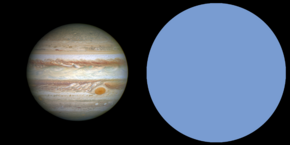 Size comparison of Jupiter with Upsilon Andromedae b | |
| Discovery | |
|---|---|
| Discovered by | Marcy et al. |
| Discovery site | California and Carnegie Planet Search |
| Discovery date | June 23, 1996 |
| Radial velocity | |
| Orbital characteristics | |
| Apastron | 0.0601 AU |
| Periastron | 0.0587 AU |
| 0.0594±0.0003 AU[1] | |
| Eccentricity | 0.012±0.005[1] |
| 4.617111±0.000014 d[1] (0.01264096 a; 110.8107 h) | |
| Inclination | 24±4[1] |
| 2,450,034.05±0.33[1] | |
| 44.11±25.56[1] | |
| Semi-amplitude | 70.51±0.37[1] |
| Star | Upsilon Andromedae |
| Physical characteristics | |
| ~1.8[2]RJ | |
| Mass | 1.70+0.33 −0.24[1] MJ |
Upsilon Andromedae b (υ Andromedae b, abbreviated Upsilon And b, υ And b), formally named Saffar /ˈsæfɑːr/, is an extrasolar planet approximately 44 light-years away from the Sun in the constellation of Andromeda. The planet orbits its host star, the F-type main-sequence star Upsilon Andromedae A, approximately every five days. Discovered in June 1996 by Geoffrey Marcy and R. Paul Butler, it was one of the first hot Jupiters to be discovered. It is also one of the first non-resolved planets to be detected directly. Upsilon Andromedae b is the innermost-known planet in its planetary system.
In July 2014 the International Astronomical Union launched NameExoWorlds, a process for giving proper names to certain exoplanets and their host stars.[3] The process involved public nomination and voting for the new names.[4] In December 2015, the IAU announced the winning name was Saffar for this planet.[5] The winning name was submitted by the Vega Astronomy Club of Morocco and honours the 11th-century astronomer Ibn al-Saffar of Muslim Spain.[6]
- ^ a b c d e f g h Cite error: The named reference
Pizkorz2017was invoked but never defined (see the help page). - ^ Cite error: The named reference
Deitrick2014was invoked but never defined (see the help page). - ^ NameExoWorlds: An IAU Worldwide Contest to Name Exoplanets and their Host Stars. IAU.org. 9 July 2014
- ^ "NameExoWorlds The Process". Archived from the original on 2015-08-15. Retrieved 2015-09-05.
- ^ Final Results of NameExoWorlds Public Vote Released, International Astronomical Union, 15 December 2015.
- ^ "NameExoWorlds The Approved Names". Archived from the original on 2018-02-01. Retrieved 2016-01-17.